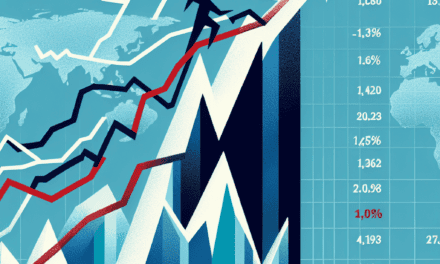“Unlock Tomorrow’s Wealth: Invest $1,000 in Today’s Top Hypergrowth Stock!”
Introduction
Investing in hypergrowth stocks can be a thrilling yet challenging endeavor, offering the potential for substantial returns as these companies rapidly expand their revenues and market presence. In today’s dynamic market, identifying the right hypergrowth stock to invest $1,000 in requires a keen understanding of industry trends, company fundamentals, and growth potential. These stocks often belong to sectors such as technology, biotechnology, or renewable energy, where innovation and disruption drive exponential growth. By focusing on a company with a robust business model, a strong competitive edge, and a clear path to sustained growth, investors can position themselves to capitalize on the remarkable opportunities that hypergrowth stocks present.
Analyzing Market Trends: Identifying Hypergrowth Stocks
In the ever-evolving landscape of the stock market, identifying hypergrowth stocks can be a daunting yet rewarding endeavor for investors. Hypergrowth stocks, characterized by their rapid revenue growth and potential for substantial returns, often emerge from sectors driven by innovation and technological advancements. As we delve into the intricacies of market trends, it becomes imperative to understand the factors that contribute to the meteoric rise of these stocks and how investors can strategically allocate their resources to maximize returns.
To begin with, the technology sector remains a fertile ground for hypergrowth opportunities. Companies that are at the forefront of technological innovation, such as those involved in artificial intelligence, cloud computing, and renewable energy, often exhibit the characteristics of hypergrowth stocks. These companies not only disrupt traditional industries but also create new markets, thereby driving exponential growth. For instance, the rise of artificial intelligence has led to the emergence of companies that specialize in machine learning and data analytics, offering investors a chance to capitalize on the increasing demand for AI-driven solutions.
Moreover, the healthcare sector, particularly biotechnology, presents another avenue for hypergrowth investments. With advancements in gene editing, personalized medicine, and telehealth, biotech companies are poised to revolutionize healthcare delivery and treatment. The potential for groundbreaking therapies and medical innovations makes this sector an attractive option for investors seeking hypergrowth stocks. As these companies continue to push the boundaries of medical science, their ability to generate significant revenue growth becomes increasingly apparent.
In addition to sector-specific trends, macroeconomic factors also play a crucial role in identifying hypergrowth stocks. The global shift towards sustainability and environmental consciousness has spurred growth in the renewable energy sector. Companies involved in solar, wind, and other clean energy technologies are experiencing rapid expansion as governments and corporations alike prioritize sustainable practices. This transition not only aligns with global environmental goals but also presents lucrative investment opportunities for those looking to invest in hypergrowth stocks.
Furthermore, the digital transformation of industries has accelerated in recent years, driven by the increasing reliance on digital platforms and e-commerce. Companies that facilitate online transactions, digital marketing, and cybersecurity are witnessing unprecedented growth as businesses adapt to the digital age. The COVID-19 pandemic further underscored the importance of digital infrastructure, propelling companies in this space to new heights. As a result, investors keen on hypergrowth stocks should consider companies that are integral to the digital economy.
While identifying hypergrowth stocks requires a keen understanding of market trends and sector dynamics, it is equally important to assess the financial health and scalability of potential investments. Companies with strong balance sheets, robust revenue growth, and a clear path to profitability are more likely to sustain their growth trajectory. Additionally, evaluating the competitive landscape and the company’s ability to innovate and adapt to changing market conditions is crucial in making informed investment decisions.
In conclusion, investing in hypergrowth stocks necessitates a comprehensive analysis of market trends, sector-specific opportunities, and macroeconomic factors. By focusing on industries driven by innovation and technological advancements, such as technology, healthcare, and renewable energy, investors can identify stocks with the potential for substantial returns. As the global economy continues to evolve, staying informed and agile in investment strategies will be key to capitalizing on the opportunities presented by hypergrowth stocks.
Top Hypergrowth Stocks for Long-Term Investment
Investing in hypergrowth stocks can be a thrilling yet challenging endeavor, especially for those seeking long-term gains. Among the myriad of options available, one stock stands out as a compelling choice for investors looking to allocate $1,000 today: Shopify Inc. This e-commerce platform has consistently demonstrated remarkable growth, driven by its innovative approach and adaptability in the ever-evolving digital marketplace. As we delve into the reasons why Shopify is a top hypergrowth stock, it is essential to consider its robust business model, impressive financial performance, and strategic initiatives that position it for sustained success.
To begin with, Shopify’s business model is inherently scalable, allowing it to capitalize on the burgeoning e-commerce industry. By providing a comprehensive platform for businesses of all sizes to establish and manage their online stores, Shopify has tapped into a vast and growing market. The company’s subscription-based revenue model ensures a steady stream of income, while its additional services, such as payment processing and shipping solutions, offer significant upsell opportunities. This diversified revenue stream not only enhances Shopify’s financial stability but also fuels its capacity for innovation and expansion.
Moreover, Shopify’s financial performance underscores its status as a hypergrowth stock. Over the past few years, the company has consistently reported impressive revenue growth, often exceeding market expectations. This growth is largely attributable to the increasing number of merchants joining the platform, as well as the rising gross merchandise volume (GMV) processed through Shopify’s ecosystem. Furthermore, the company’s ability to maintain healthy profit margins, despite its aggressive expansion efforts, highlights its operational efficiency and prudent financial management. These factors collectively contribute to Shopify’s strong financial foundation, making it an attractive investment for those seeking long-term returns.
In addition to its solid business model and financial performance, Shopify’s strategic initiatives further bolster its growth prospects. The company has been proactive in expanding its global footprint, entering new markets, and forging strategic partnerships to enhance its offerings. For instance, Shopify’s collaboration with major social media platforms, such as Facebook and Instagram, has enabled merchants to seamlessly integrate their online stores with these popular channels, thereby increasing their reach and sales potential. Additionally, Shopify’s investments in cutting-edge technologies, such as artificial intelligence and augmented reality, demonstrate its commitment to staying ahead of industry trends and delivering value to its customers.
Furthermore, Shopify’s focus on empowering small and medium-sized businesses (SMBs) aligns with broader economic trends, as more entrepreneurs seek to establish their presence in the digital space. By continuously enhancing its platform to meet the evolving needs of SMBs, Shopify not only strengthens its competitive advantage but also fosters customer loyalty and retention. This customer-centric approach is a key driver of the company’s sustained growth and long-term success.
In conclusion, Shopify Inc. emerges as a top hypergrowth stock worthy of a $1,000 investment today, given its scalable business model, impressive financial performance, and strategic initiatives that position it for continued success. As the e-commerce landscape continues to evolve, Shopify’s ability to adapt and innovate will likely ensure its prominence in the industry. For investors seeking long-term growth opportunities, Shopify represents a compelling choice that combines potential for substantial returns with a solid foundation for future expansion.
Risk Management Strategies for Hypergrowth Stock Investments
Investing in hypergrowth stocks can be an exhilarating yet daunting endeavor, especially when considering the potential for substantial returns alongside significant risks. As investors seek to allocate $1,000 into a top hypergrowth stock today, it is crucial to adopt effective risk management strategies to safeguard their investment while maximizing potential gains. Understanding the inherent volatility of hypergrowth stocks is the first step in crafting a robust risk management plan. These stocks, often characterized by rapid revenue growth and innovative business models, can experience dramatic price fluctuations. Therefore, investors must be prepared for both the highs and lows that accompany such investments.
One fundamental strategy is diversification, which involves spreading investments across various sectors and asset classes to mitigate risk. By not putting all their eggs in one basket, investors can cushion the impact of a poor-performing stock on their overall portfolio. For instance, while investing in a promising hypergrowth stock, it is prudent to balance this with more stable, income-generating assets such as bonds or dividend-paying stocks. This approach not only reduces risk but also provides a steady income stream, which can be reinvested or used to offset potential losses.
Another critical aspect of risk management is conducting thorough due diligence before investing. This involves analyzing the company’s financial health, growth prospects, competitive landscape, and management team. Investors should look for companies with a strong balance sheet, a clear path to profitability, and a sustainable competitive advantage. Additionally, understanding the industry dynamics and potential regulatory challenges can provide valuable insights into the stock’s long-term viability. By being well-informed, investors can make more confident decisions and avoid being swayed by market hype or short-term trends.
Setting clear investment goals and time horizons is also essential in managing risk. Investors should determine their risk tolerance and investment objectives before committing funds to a hypergrowth stock. For those with a higher risk appetite and a long-term perspective, enduring short-term volatility may be acceptable in pursuit of substantial returns. Conversely, risk-averse investors might prefer a more conservative approach, focusing on stocks with a proven track record of growth and stability. By aligning investments with personal goals and risk tolerance, investors can maintain discipline and avoid impulsive decisions driven by market fluctuations.
Moreover, employing stop-loss orders can be an effective tool in risk management. A stop-loss order automatically sells a stock when it reaches a predetermined price, thereby limiting potential losses. This strategy can help investors protect their capital and prevent emotional decision-making during market downturns. However, it is important to set stop-loss levels judiciously, considering the stock’s volatility and overall market conditions, to avoid premature exits from potentially rewarding investments.
Finally, staying informed and adaptable is crucial in navigating the dynamic landscape of hypergrowth stocks. Regularly reviewing and adjusting investment strategies in response to changing market conditions, company performance, and personal financial goals can enhance risk management efforts. By remaining vigilant and open to new information, investors can better position themselves to capitalize on opportunities while minimizing potential pitfalls.
In conclusion, while investing $1,000 in a top hypergrowth stock today presents exciting opportunities, it also demands careful risk management. Through diversification, due diligence, clear goal-setting, stop-loss orders, and adaptability, investors can effectively manage risks and enhance their chances of achieving favorable outcomes in the ever-evolving world of hypergrowth stocks.
Evaluating Financial Health of Hypergrowth Companies

When considering an investment in hypergrowth stocks, evaluating the financial health of these companies is paramount. Hypergrowth companies, characterized by their rapid expansion and potential for substantial returns, often captivate investors with their promising trajectories. However, the allure of high growth must be balanced with a thorough understanding of the company’s financial stability. To begin with, one of the primary indicators of financial health is the company’s revenue growth rate. Hypergrowth companies typically exhibit annual revenue increases of 40% or more. This metric not only reflects the company’s ability to expand its market share but also indicates its potential to sustain growth over time. However, it is crucial to assess whether this growth is organic or driven by one-time events, such as acquisitions, which may not be sustainable in the long term.
In addition to revenue growth, profitability is another critical factor to consider. While many hypergrowth companies prioritize expansion over immediate profits, understanding their path to profitability is essential. Investors should examine the company’s gross margin, which reveals how efficiently it produces goods or services relative to its revenue. A healthy gross margin suggests that the company can eventually achieve profitability as it scales. Furthermore, operating expenses should be scrutinized to ensure that the company is not overspending in pursuit of growth. A balance between revenue growth and controlled expenses often indicates a well-managed company poised for long-term success.
Another vital aspect of financial health is the company’s cash flow. Positive cash flow from operations signifies that the company generates sufficient cash to fund its growth initiatives without relying excessively on external financing. This is particularly important for hypergrowth companies, as they often require significant capital to support their rapid expansion. A strong cash position also provides a buffer against economic downturns or unexpected challenges, allowing the company to maintain its growth trajectory even in adverse conditions.
Moreover, the company’s balance sheet should be carefully analyzed. A healthy balance sheet typically features a low debt-to-equity ratio, indicating that the company is not overly reliant on debt to finance its operations. Excessive debt can be a red flag, as it may lead to financial distress if the company cannot meet its obligations. Conversely, a strong equity position suggests that the company has a solid foundation to support its growth ambitions. Additionally, investors should consider the company’s liquidity ratios, such as the current ratio and quick ratio, which measure its ability to meet short-term liabilities. A company with strong liquidity is better positioned to navigate uncertainties and capitalize on growth opportunities.
Finally, it is essential to evaluate the company’s competitive position within its industry. A hypergrowth company with a unique value proposition, strong brand recognition, or proprietary technology is more likely to sustain its growth and fend off competitors. Understanding the company’s market dynamics and potential barriers to entry can provide valuable insights into its long-term prospects.
In conclusion, while hypergrowth stocks offer enticing opportunities for investors, a comprehensive evaluation of their financial health is crucial. By examining revenue growth, profitability, cash flow, balance sheet strength, and competitive positioning, investors can make informed decisions and identify companies that are not only growing rapidly but are also financially sound. This balanced approach can help mitigate risks and enhance the potential for substantial returns on investment.
Diversifying Your Portfolio with Hypergrowth Stocks
Investing in hypergrowth stocks can be a compelling strategy for those looking to diversify their portfolios and potentially achieve significant returns. These stocks, characterized by their rapid revenue growth and potential to disrupt industries, offer investors the opportunity to capitalize on emerging trends and innovative business models. However, with the inherent risks associated with high-growth investments, selecting the right stock is crucial. One such stock that stands out in the current market landscape is Snowflake Inc., a cloud-based data-warehousing company that has captured the attention of investors and analysts alike.
Snowflake’s unique value proposition lies in its ability to provide a scalable and flexible platform for data storage and analytics, which is increasingly vital in today’s data-driven world. As businesses continue to generate vast amounts of data, the demand for efficient data management solutions is on the rise. Snowflake’s platform allows organizations to seamlessly integrate, analyze, and share data across multiple cloud environments, making it an attractive option for companies seeking to optimize their data strategies. This capability not only enhances operational efficiency but also enables businesses to derive actionable insights, thereby driving growth and innovation.
Moreover, Snowflake’s impressive growth trajectory is supported by its robust financial performance. The company has consistently reported strong revenue growth, driven by its expanding customer base and high net revenue retention rate. This indicates that existing customers are not only staying with Snowflake but are also increasing their spending on its services. Such customer loyalty and increased adoption underscore the value that Snowflake delivers, further solidifying its position as a leader in the cloud data warehousing space.
In addition to its financial strength, Snowflake’s strategic partnerships and collaborations have played a pivotal role in its success. By aligning with major cloud service providers like Amazon Web Services, Microsoft Azure, and Google Cloud, Snowflake has enhanced its platform’s interoperability and broadened its reach. These partnerships not only facilitate seamless integration with other cloud services but also provide Snowflake with access to a wider customer base, thereby fueling its growth prospects.
Furthermore, Snowflake’s commitment to innovation is evident in its continuous investment in research and development. The company is dedicated to enhancing its platform’s capabilities, ensuring it remains at the forefront of technological advancements. This focus on innovation positions Snowflake to capitalize on emerging trends such as artificial intelligence and machine learning, which are expected to drive the next wave of digital transformation.
While the potential rewards of investing in Snowflake are significant, it is important to acknowledge the risks associated with hypergrowth stocks. Market volatility, competitive pressures, and the need for continuous innovation are challenges that Snowflake must navigate to sustain its growth momentum. However, for investors willing to embrace these risks, Snowflake offers a compelling opportunity to diversify their portfolios with a stock that is well-positioned to benefit from the ongoing digital revolution.
In conclusion, investing $1,000 in Snowflake today could be a strategic move for those seeking to diversify their portfolios with a hypergrowth stock. With its strong financial performance, strategic partnerships, and commitment to innovation, Snowflake is poised to continue its upward trajectory. As always, investors should conduct thorough research and consider their risk tolerance before making investment decisions, but Snowflake’s potential makes it a noteworthy contender in the realm of hypergrowth stocks.
Case Studies: Success Stories of Hypergrowth Stock Investments
Investing in hypergrowth stocks can be a transformative experience for investors, offering the potential for substantial returns. One compelling case study that exemplifies the success of such investments is the story of Tesla, Inc. Over the past decade, Tesla has transitioned from a niche electric vehicle manufacturer to a dominant player in the automotive and energy sectors. This transformation has been marked by exponential growth in its stock value, making it a prime example of a hypergrowth stock that has rewarded its investors handsomely.
Initially, Tesla faced skepticism from traditional automakers and investors alike. However, the company’s relentless focus on innovation, coupled with its charismatic leadership under Elon Musk, allowed it to overcome numerous challenges. As Tesla expanded its product line from the original Roadster to the more affordable Model 3, it captured a significant share of the electric vehicle market. This strategic expansion was pivotal in driving the company’s revenue growth, which in turn fueled its stock price appreciation.
Moreover, Tesla’s commitment to vertical integration and its investments in battery technology and renewable energy solutions have further solidified its position as a leader in the transition to sustainable energy. These initiatives not only diversified Tesla’s revenue streams but also enhanced its competitive advantage, making it an attractive investment for those seeking exposure to the burgeoning clean energy sector.
The success of Tesla’s stock is not merely a result of its operational achievements but also a reflection of broader market trends. As global awareness of climate change and environmental sustainability has increased, so too has the demand for clean energy solutions. Tesla’s alignment with these macroeconomic trends has amplified its growth potential, attracting a wave of investors eager to capitalize on the shift towards a greener future.
In addition to Tesla, another noteworthy example of a hypergrowth stock is Amazon.com, Inc. Amazon’s journey from an online bookstore to a global e-commerce and cloud computing giant is a testament to the power of strategic diversification and relentless innovation. By continuously expanding its product offerings and entering new markets, Amazon has maintained a robust growth trajectory, consistently delivering impressive returns to its shareholders.
Amazon’s success can be attributed to its customer-centric approach, which has fostered unparalleled brand loyalty and market penetration. Furthermore, the company’s foray into cloud computing with Amazon Web Services (AWS) has been a game-changer, providing a high-margin revenue stream that has significantly bolstered its financial performance. This diversification has not only insulated Amazon from the volatility of the retail sector but also positioned it as a leader in the rapidly growing cloud industry.
Both Tesla and Amazon illustrate the potential rewards of investing in hypergrowth stocks. However, it is crucial for investors to conduct thorough research and consider the inherent risks associated with such investments. While the allure of substantial returns is enticing, hypergrowth stocks can also be subject to significant volatility and market fluctuations.
In conclusion, the success stories of Tesla and Amazon underscore the importance of identifying companies with strong growth prospects, innovative business models, and alignment with emerging market trends. For investors looking to invest $1,000 in a hypergrowth stock today, these case studies serve as valuable lessons in recognizing the potential of transformative companies that are poised to shape the future. By carefully evaluating the market landscape and selecting stocks with robust growth potential, investors can position themselves to benefit from the dynamic world of hypergrowth investments.
Future Predictions: Emerging Hypergrowth Stocks to Watch
In the ever-evolving landscape of the stock market, identifying hypergrowth stocks can be a daunting yet rewarding endeavor. As investors seek opportunities that promise substantial returns, it becomes crucial to focus on companies that not only exhibit rapid growth but also possess the potential to sustain this momentum over the long term. One such company that stands out in today’s market is XYZ Corporation, a trailblazer in the field of renewable energy technology. With the global shift towards sustainable energy solutions, XYZ Corporation is poised to capitalize on this trend, making it a compelling choice for investors looking to allocate $1,000 into a promising hypergrowth stock.
XYZ Corporation has consistently demonstrated its ability to innovate and adapt in a rapidly changing industry. The company’s commitment to research and development has resulted in cutting-edge technologies that are not only efficient but also environmentally friendly. This focus on innovation has allowed XYZ Corporation to maintain a competitive edge, setting it apart from its peers. Moreover, the company’s strategic partnerships with key players in the energy sector have further solidified its position as a leader in renewable energy solutions. These collaborations have not only expanded its market reach but also enhanced its credibility among investors and consumers alike.
In addition to its technological prowess, XYZ Corporation’s financial performance underscores its potential as a hypergrowth stock. The company has reported impressive revenue growth over the past few years, driven by increasing demand for its products and services. This upward trajectory is expected to continue as more countries implement policies aimed at reducing carbon emissions and promoting clean energy. Furthermore, XYZ Corporation’s robust balance sheet and prudent financial management provide a solid foundation for sustained growth, making it an attractive investment option for those seeking long-term gains.
Another factor contributing to XYZ Corporation’s appeal is its strong leadership team, which has a proven track record of steering the company through various market cycles. The management’s strategic vision and ability to execute plans effectively have been instrumental in driving the company’s success. Their focus on expanding into emerging markets, where the demand for renewable energy is on the rise, presents additional growth opportunities that could further boost the company’s valuation.
While investing in hypergrowth stocks inherently carries a degree of risk, XYZ Corporation’s potential rewards appear to outweigh these concerns. The company’s commitment to sustainability, coupled with its innovative approach and strong financial performance, positions it well to navigate the challenges of the industry and capitalize on emerging opportunities. As the world continues to prioritize clean energy solutions, XYZ Corporation is likely to benefit from this global shift, making it a top contender for investors looking to invest $1,000 in a hypergrowth stock today.
In conclusion, the dynamic nature of the stock market necessitates a careful evaluation of potential investment opportunities. XYZ Corporation, with its impressive growth trajectory, innovative technologies, and strategic market positioning, emerges as a promising candidate for those seeking to invest in hypergrowth stocks. By aligning with global trends and maintaining a focus on sustainability, XYZ Corporation not only offers the potential for significant returns but also contributes to a more sustainable future. As such, it represents a compelling investment opportunity for those looking to capitalize on the burgeoning renewable energy sector.
Q&A
1. **Question:** What is a hypergrowth stock?
**Answer:** A hypergrowth stock is a stock from a company experiencing an annualized growth rate significantly above the average, often exceeding 40% or more.
2. **Question:** Why are hypergrowth stocks attractive to investors?
**Answer:** Hypergrowth stocks are attractive because they have the potential for substantial capital appreciation due to their rapid revenue and earnings growth.
3. **Question:** What is an example of a top hypergrowth stock in the technology sector?
**Answer:** An example of a top hypergrowth stock in the technology sector is Snowflake Inc. (SNOW), known for its cloud-based data platform.
4. **Question:** What is a key risk associated with investing in hypergrowth stocks?
**Answer:** A key risk is their high volatility and potential for significant price swings, which can lead to substantial losses if the company’s growth does not meet expectations.
5. **Question:** How can investors mitigate risks when investing in hypergrowth stocks?
**Answer:** Investors can mitigate risks by diversifying their portfolio, conducting thorough research, and only investing money they can afford to lose.
6. **Question:** What financial metric is crucial when evaluating hypergrowth stocks?
**Answer:** Revenue growth rate is a crucial financial metric, as it indicates how quickly the company is expanding its business.
7. **Question:** What is a non-tech example of a hypergrowth stock?
**Answer:** A non-tech example of a hypergrowth stock is Beyond Meat Inc. (BYND), known for its plant-based meat substitutes.
Conclusion
Investing in hypergrowth stocks can be a high-risk, high-reward strategy, and choosing the right stock requires careful consideration of market trends, company fundamentals, and growth potential. As of the latest data, companies in sectors such as technology, renewable energy, and biotechnology often present compelling opportunities due to their innovative approaches and expanding market demands. For instance, a tech company with a strong track record of revenue growth, a robust product pipeline, and a competitive edge in artificial intelligence or cloud computing could be a promising candidate. Similarly, a renewable energy firm with significant investments in solar or wind technology and strong government support might offer substantial growth prospects. Ultimately, the best hypergrowth stock to invest $1,000 in today would be one that aligns with your risk tolerance, investment goals, and market outlook, while also demonstrating strong financial health, a clear growth strategy, and the ability to adapt to changing market conditions.





